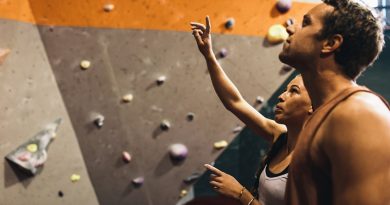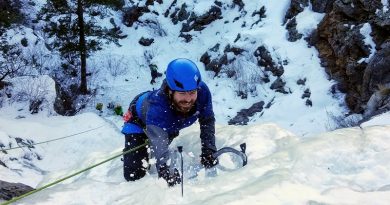Rock climbing rules for a variety of reasons: it’s fun, it’s challenging, and it’s rewarding.
But did you know that it burns calories, too? In fact, some research suggests that traditional rock climbing and bouldering are two of the best exercises you can use to stay fit. In this guide, we’ll take an in-depth look at just how many calories you can burn with these activities.
In order to do so, I’ll break down some rock climbing basics to give you the most accurate data.

Rock Climbing: The Ultimate Workout
Recent research indicates that rock climbing is not just a good exercise—it may be one of the best.
But why is this the case?
For starters, rock climbing asks you to stay in constant motion. The dynamic sport also requires that you routinely shift your position and work different muscle groups. This results largely from the fact that no two crags are the same.
As you might expect, then, rock climbing burns some serious calories. Keep reading to find out how many!
Counting Calories
In order to calculate how many calories you burn during your rock climbing trip, we must first establish a formula.
Namely, we need an equation that tells us how many calories you can burn doing X hours of rock climbing at Y rate of caloric burn.
This means we must first find out how many calories rock climbing burns per hour. The research on this varies. As it turns out, there isn’t one straight answer to this question.
Some research suggests that rock climbing burns between 500 to 900 calories per hour (yes, you read that correctly). Obviously, that’s some serious caloric burn. Still, it comes with the condition that you don’t rest for extended periods of time between each of your routes.
Other research indicates that climbers burn between eight to ten calories per minute while climbing. Assuming your pitch takes one hour to climb, this still gives us a caloric burn of around 600 calories.
By this point, you’re probably getting pretty excited. After all, some climbing sessions can take several hours. Assuming your session took three hours, and you burned at least 600 calories, per hour, there’s a chance you burned 1,800 to 2,000 calories—right?
The answer is, “It depends.”
Remember that you should only include the time you spent actively climbing. This means you’ll need to cut out the time you spend resting, chatting, or belaying (more on that soon). By doing so, you may find yourself with a wildly different estimation.
Can You Burn Calories While Belaying?
“Okay,” you say, “So I can’t count my whole climbing session. But can I at least count the time I spent belaying?”
I get it—after all, belaying still counts as work.
But is it as intensive as climbing? In other words, do you still burn an insane number of calories while belying?
Unfortunately, no.
The reason is actually pretty simple. Unlike climbing, belaying rarely asks you to do heavy amounts of work. Instead, it requires you only to feed the rope to your partner and lower your partner when necessary.
As you know, this hardly constitutes a heavy workout.
Still, you are moving, so you will be burning some calories. Unfortunately, the number is likely to be negligible.
Again, this means you are better off counting only the number of calories you burn while actively climbing. Doing so will give you a more accurate estimation of your caloric burn and help you better manage your fitness progress.
What About Bouldering?
For all you boulderers out there, don’t worry—bouldering constitutes great exercise, as well.
As with traditional rock climbing, bouldering requires you to move extensively. In other words, the sport forces you to work out a variety of muscle groups. Obviously, this entails a high level of caloric burn.
But how much? Again, estimates say between 500 to 900 calories. Still, it’s important to note that this only takes into account the time you spend actively climbing. Some climbers find it easier to burn while bouldering, simply because they spend less time on the ground (belaying) and more time climbing.
If you’re having trouble tracking the amount of time you spend in the air, consider bringing a stopwatch or timing your climbs on your mobile device. Of course, this won’t be one hundred percent accurate, but the method allows for a more-or-less accurate estimation of the time you spend moving. This means that you’ll have a better idea of how many calories you actually burn.
Other Factors to Consider
What other factors may influence the number of calories you burn while rock climbing?
Research suggests that weight is a significant factor. Because your body requires more energy to function when you are carrying extra weight, those who are heavier than normal may experience more dramatic caloric burn while climbing.
Additionally, climbers who climb with more or with heavier gear may also burn more calories. This is because the extra weight forces more effort, which in turn burns more calories.
Remember that, unless you have access to lab data, the number of calories you burn rock climbing will largely be an estimate. This means that you should leave room for error when calculating so that you can fulfill your fitness goals.
Conclusion
Everyone loves burning calories.
Fortunately for you, rock climbing provides you with the opportunity to burn calories like never before! This intensive sport activates several muscle groups throughout your body and provides you with an intense full body workout.
Whether you are an experienced climber who’s looking to track her weight or a beginner looking for a fun way to burn calories, rock climbing is the way to go. Along with bouldering, this traditional sport gives you the potential to maximize your caloric burn and start shedding those pounds.
So what are you waiting for? It’s time to grab your gear and go! The crags are calling, and your body’s just waiting to get that next workout. Don’t forget to bring your stopwatch so you can time your session.
Who knows? You may burn more than you think!






